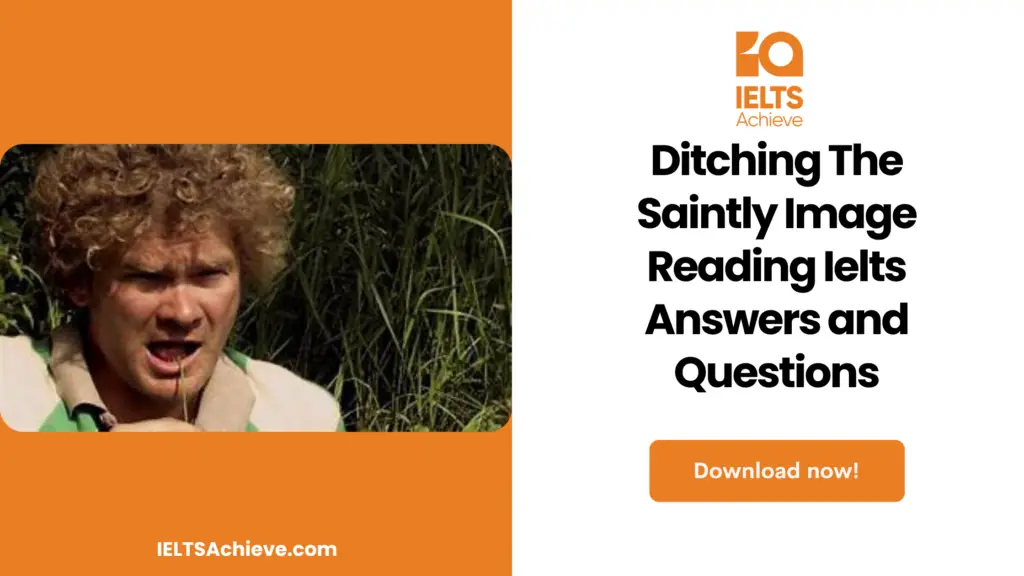The Blog post contains the following IELTS Reading Questions:
- IELTS Reading Multiple Choice Questions
- IELTS Reading True/False/Not Given
Stay informed and prepared for success – Explore our comprehensive Reading Test Info page to get valuable insights, exam format details, and expert tips for mastering the IELTS Reading section.
Ditching The Saintly Image IELTS Reading passage

Ditching that Saintly Image
A. Charities, it is still widely believed, are separate from the government, staffed entirely by volunteers and spend every penny donated on the cause they support. Noble stuff, but in most cases entirely wrong. Yet these misapprehensions underpin much of the trust and goodwill behind giving. And there is concern that such outdated perceptions could blow up in charities’ faces as people begin to discover what the voluntary sector is really about.
B. High profile international programmes of awareness-raising activities such as Make Poverty History have dragged the voluntary sector into the spotlight and shown charity workers to be as much business entrepreneurs as they are angels of mercy. But with the spotlight comes scrutiny and unless charities present compelling cases for political campaigning, six-figure salaries and paying the expenses of celebrities who go on demanding trips to refugee camps for nothing, they may get bitten. If people become more sceptical about how charities use their donations, they will be less inclined to give money,’ says Nick Aldridge, director of the strategy at the Association of Chief Executives of Voluntary organisations (ACEVO)
C. A wide range of initiatives has been undertaken to secure long-term trust in the sector by explaining what charities do and publishing the figures. But it’s still difficult to give donors a complete picture because, unlike profit-driven businesses, charities can’t measure achievement purely by the bottom line.
D. The report Funding Success suggests this might explain some of the communication difficulties charities face. Nevertheless, it suggests there are sound reasons for trying. Many funders, it claims, regard high overheads on, for example, premises, publicity and so on, that are properly accounted for as a sign of an efficiently run organisation, rather than a waste of resources. Detailed reporting can be an important element in efforts to increase transparency. Better information might also unlock more money by highlighting social problems, and explaining what might be done to address them.
E. Some charities are also taking steps in this direction. The Royal National Institute For The Deaf (RNID) introduced annual Impact reporting to tell people about the effects of its work in a broader sense than an annual report would usually allow.
F. Each impact report looks back at what has been achieved over the previous 12 months and also states the charity’s aims for the year ahead. Brian Lamb, director of communications at RNID, says the sector has been complacent about transparency because of the high level of trust it enjoys. ‘We have not been good at educating the public on issues such as why we do a lot of campaigning,’ he says. ‘But, the more high profile the sector becomes, the more people will ask questions.
G. Baroness Onora O’Neill, chair of the Nuffield Foundation, says building trust goes deeper than providing information. She points out that the additional reporting and accounting requirements imposed on institutions across all sectors in recent years may have made them more transparent, but it has not made them more trusted. If we are to judge for ourselves, we need genuine communication in which we can question and observe, check and even challenge the evidence that others present. Laying out the evidence of what has been done, with all its shortcomings, may provide a rather better basis for placing – or refusing trust than any number of glossy publications that trumpet unending success.
H. Not everyone thinks the public needs to be spoon-fed reams of information to maintain confidentiality. ‘There isn’t any evidence that there is a crisis of confidence in charities,’ says Cathy Pharoah, research director at the Charities Aid Foundation. The facts support her claim. In a Charity Commissions report published in November last year, the public awarded charities 63 out of 10 on trust. Pharoah believes key donors are savvier than they are portrayed. ‘There is heavy dependence on middle-class donors for charity income, and I would be amazed if they didn’t realize charities had to pay to get professional staff, she says.
I. She believes the biggest threats to trust are the kind of scandals that blighted the Scottish voluntary sector in 2003. Two high-profile charities, Breast Cancer Research (Scotland) and Moonbeams, were exposed for spending a fraction of their profits on their causes. The revelations created intensely damaging media coverage. Even charity stalwarts were shocked by how quickly the coverage snowballed as two bad stories turned into a sector-wide crisis. ‘Those two incidents caused a media frenzy as journalists took every opportunity to undermine the sector,’ says Fiona Duncan, director of external affairs at Capability Scotland. After suffering a media grilling herself, Duncan launched Giving Scotland to redress the balance. Fourteen charities plus the Scottish Council for Voluntary Organisations and the institution of Fund Raising Scotland Joined together to put out communications restoring confidence in charities. The Scottish executive pledged £30,000 and with donations from corporate supporters, the campaign was able to secure advertising worth £300,000 for a lightning two-week campaign over Christmas 2003.
J. Two months before the campaign was launched, The Herald newspaper published a poll revealing that 52 percent of the people were less likely to give because of the scandals. Giving Scotland did a similar poll in February 2004 and this time more than half of the population said they were more likely to consider giving because of the campaign. ‘We learned about strength in numbers, and the importance of timing – because it was Christmas we were able to get good coverage,’ says Duncan.
K. It was an effective rearguard campaign. The numerous proactive initiatives now underway across the UK give charities the chance to prevent the situation ever getting that bad again – but their success will depend on whether they are prepared to shed their saintly image and rally to the cause of creating a newer, bolder one.
Questions
Questions 1-7
Choose the correct letter A, B, C, or D
1. What do we learn about charities in the first paragraph
A. People trust charities because they are approved by the government
B. Not all the funds a charity receives to go on practical aid for people
C. Charities do not disclose their systems for fear of losing official status
D. People who work for charities without pay are not fit for the job.
2. Why in the writer’s view is it hard for charities to inform the public properly
A. They calculate their success differently from other businesses
B. They are unable to publish a true financial report.
C. The number of resources needed changes radically, year by year
D. Donors may be disappointed if they see large profits in the business
3. One of the conclusions of the report ‘Funding Success’ is that
A. Charities must cut down on any unnecessary expenditure.
B. Raising more money for their cause should be the charity’s main aim
C. Charities should give the public an assessment of the results of their work.
D. Clarifying the reasons for administration costs would not dissuade donors
4. Baroness O’ Neill’s main recommendation is that charities should
A. Follow the current government’s requirements for reporting.
B. Encourage the people to examine and discuss the facts
C. Publicise any areas in which they have been effective.
D. Make sure the figures are laid out as clearly as possible.
5. What is Cathy Pharoah most concerned about
A. The public’s adverse reaction to the money spent on charity personnel
B. The effect on general donations if a charity misuses their funds
C. The reliance of many charities on a single sector of the population
D. The findings of a Charity Commissions report on public confidence
6. Why does Fiona Duncan think the Giving Scotland campaign succeeded
A. The message came over strongly because so many organisations united
B. People did not believe the critical stories that appeared in newspapers
C. Private donors paid for some advertising in the national press
D. People forgot about the scandals over the Christmas holidays
7. The writer suggests that in the future charities
A. May well have to face a number of further scandals
B. Will need to think up some new promotional campaigns
C. May find it hard to change the public’s perception of them.
D. Will lose the public’s confidence if they modernise their image
Questions 8-14
Do the following statements agree with the information given in Reading Passage
- TRUE if the statement agrees with the information
- FALSE if the statement contradicts the information
- NOT GIVEN if there is no information on this
8. Charity involvement in some prominent campaigns has meant that they are undergoing a more careful examination by the public.
9. Famous people insist on a large fee if they appear for a charity
10. The new RNID documents outline expected to progress as well as detailing past achievements
11. People have been challenging the RNID on their promotional activities
12. The two charities involved in a scandal have altered their funding program
13. Following the scandal, the media attacked the charity sector as a whole
14. Charity donations in Scotland are back to their pre-scandal level
Enhance your skills in identifying information as True, False, or Not Given. Click here to discover expert strategies and techniques for mastering this question type in the IELTS Reading section.
Unlock your full potential in the IELTS Reading section – Visit our IELTS Reading Practice Question Answer page now!
Recommended Questions:
Renewable Energy IELTS Reading Question with Answer
Answers for Ditching The Saintly Image
1. Answer: B
2. Answer: A
3. Answer: D
4. Answer: B
5. Answer: B
6. Answer: A
7. Answer: C
8. Answer: True
9. Answer: Not given
10. Answer: True
11. Answer: False
12. Answer: Not given
13. Answer: True

We hope you found this post useful in helping you to study for the IELTS Test. If you have any questions please let us know in the comments below or on the Facebook page.
The best way to keep up to date with posts like this is to like us on Facebook, then follow us on Instagram and Pinterest. If you need help preparing for the IELTS Test, join the IELTS Achieve Academy and see how we can assist you to achieve your desired band score. We offer an essay correction service, mock exams and online courses.

